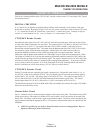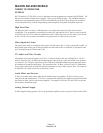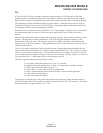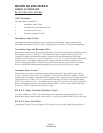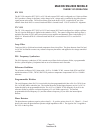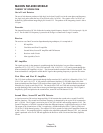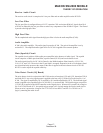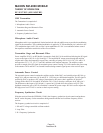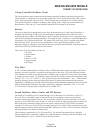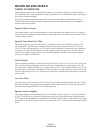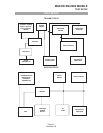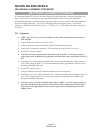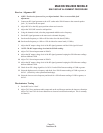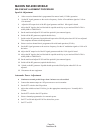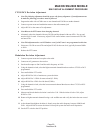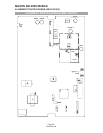
Voltage Controlled Oscillator Circuit
The circuit produces carrier frequencies during transmit and local oscillator frequencies during receive.
Transistor Q107 is configured as a power supply ripple filter. The VCO utilizes transistor Q108, varactor
D101 , D102 and trimmer capacitor TC101 . These components are configured as a Colpitts oscillator.
D101 and D102 produce a change in frequency with a change in DC voltage and are controlled by the
phase detector. Q110 and Q111 are an amplifier and buffer for the output of the oscillator.
Receiver
The receive signal passes through the low pass filter, then onward to pin 1 of the Front End module. A
bandpass filter consisting of C801-C810 (see band chart for different band values) and L801-L803 is
coupled to the base of Q801 (2SC5084) which is the RF amplifier. Diode D801 serves as protection from
static and RF overload from nearby transmitters. The output of Q801 is coupled to a second bandpass filter
consisting of C812-C824 and L804-L807. The output of the Front End ( pin 6) is coupled to the double
balanced mixer IC102. The receiver Front End Module is factory pre-tuned and requires no field
adjustment. Repair is effected by replacement of the entire (properly banded) module. Frequency bands are
listed in the SPECIFICATIONS section of this manual.
The receiver Front End module pin-outs are:
1. RF Input
2. Input Ground
3. Ground
4. Receive +5VDC
5. Output Ground
6. RF Output
First Mixer
IC102 is a Double Balanced Mixer which provides a 45MHz intermediate frequency output. The filtered
frequency from the Front End is coupled to signal input pin3 of the mixer. The Local Oscillator from the
VCO module runs 45MHz lower than the receive frequency and is coupled to IC102 at pin6. The resultant
IF output exits at mixer pin2. The 45MHz IF output is matched to the input of the 4 pole monolithic crystal
filter by C179 , L119 , C172 and C173 . The crystal filter provides a bandwidth of + and - 7.5kHz from the
operating frequency for the signal providing a high degree of spurious and intermodulation protection.
Additionally, a 90MHz trap is placed at the filter input to provide additional attenuation of the second order
IMD (Intermodulation Distortion). The output of the filter is impedance matched by T101 , C175 , and
C176 to the base of the post filter IF amplifier Q130 ( MMBC1321 ).
Second Oscillator- Mixer- Limiter and FM Detector
The output of IF amplifier Q130 is coupled through C182 to the input of IC109 (Pin16), an MC3371
device. IC109 is a monolithic single-conversion FM receiver containing a mixer, the second local
oscillator, limiter and quadrature detector. The second local oscillator is crystal-controlled by X101 and
operates at 44.545 Mhz. Mixing the second L.O. with the 45.0 Mhz IF input signal provides a resultant 455
kHz signal at the second mixer output. The mixer output is then routed to CF103 (455HT) for channel
spacing of 12.5 kHz or to CF104 (455F) for channel spacing of 20 or 25kHz. These ceramic filters provide
adjacent channel selectivity for the desired bandwidths. Selection of CF103 or CF104 is software controlled
and programmable on a channel to channel basis.
Filter selection is performed by Q135, D126 and D126. The selected filter output drives a high gain
limiting amplifier that is internally coupled to the quadrature detector. Refering to the RF schematic, with
Channel Spacing low, Q135 is off and CF104 is the selected filter.
MAXON SM-2000 MOBILE
THEORY OF OPERATION
Page-19-
December 98



